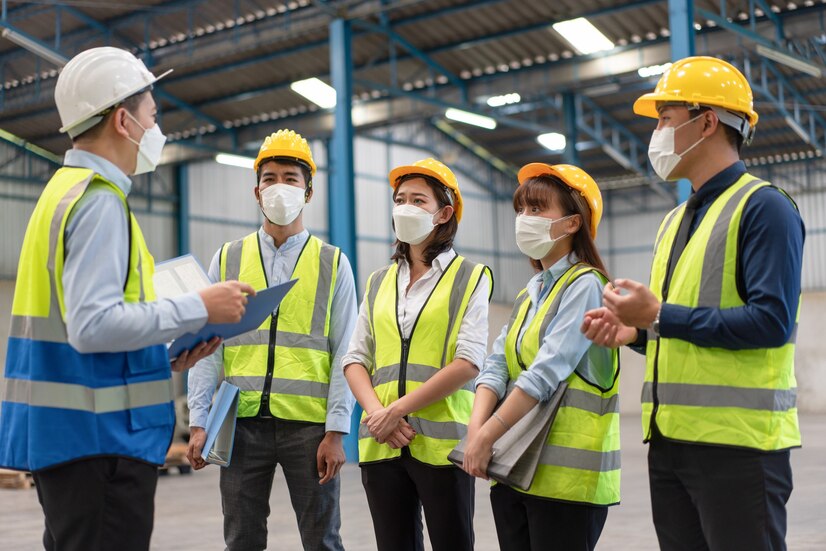How To Motivate Your Employees To Wear Appropriate PPE?
5 Mins Read
Published on: 06 October 2022
Last Updated on: 11 October 2023

toc impalement
While business owners are required to keep up to date with Personal Protective Equipment (PPE) at work regulations, the need for PPE in the workplace goes far beyond simple moral and legal obligation; whatever field or industry you’re working in, it’s essential that your employees have relevant training and sufficient access to the necessary PPE to complete their jobs safely without accident or injury.
What is PPE stand for?PPE stands for personal protective equipment. Now, every fieldwork you are involved in wearing PPE comes under regular safety compliances.
As an employer, how can you go about encouraging your staff to make use of appropriate PPE when they’re carrying out their daily roles?
What Are The Possible Consequences Of Workplace Accidents?

PPE is primarily designed to protect workers against workplace accidents, which can lead to serious staff injuries and fatalities.
As well as implications for the health and well-being of the injured party, your business could face devastating consequences as a result of an injury arising from malpractice or negligence, such as reputational damage, reduced productivity, and expensive legal fees.
A construction accident law firm can provide valuable assistance in such situations. These firms specialize in handling cases related to construction accidents and workplace injuries, ensuring that your business is properly represented and protected in legal matters.
The link between proper safety training and PPE use and injuries in the workplace has been well established in construction industry case studies, but PPE can reduce accidents or injuries in a wide variety of job roles, including those not traditionally considered risky or dangerous.
How Can You Motivate Your Employees To Wear PPE?

Once you’ve followed PPE workplace regulations and provided your staff with all of the relevant PPE that they need for their jobs, what can you do to make sure that they use it?
1. Have A Clear Safety Policy In Place –
Conduct a thorough risk assessment of your business, workplace, and operations, and use the information you gather to inform a company safety policy.
A comprehensive company safety policy is a foundational document that prioritizes the safety and well-being of the workforce. Key elements include a clear commitment statement and top management to individual employees defining roles and responsibilities. It outlines procedures for hazard identification, risk assessment, regular inspections, and hazard reporting systems, and it may also include safety committees.
A company’s safety policy details the types, eligibility, and frequency of safety training and education training. At the same time, ensure employees are well-prepared with emergency response protocols, including evacuation plans and fire safety. The policy also guides incident reporting, investigation, and prevention processes.
Additionally, a safety policy provides specifics about safety equipment and personal protective gear, emphasizing provision, maintenance, and proper use. It encourages employee health and wellness programs, such as regular check-ups. Fostering a strong safety culture focusing on continuous improvement through policy review, consequences for non-compliance, and clear communication channels is advisable.
A safety policy also addresses document control, review frequency, and means of disseminating safety information. It recognizes the vital role of employee involvement in safety initiatives, reporting, and suggestions.
Once you’ve written a watertight safety policy, ensure that all of your workers are familiar with it and have undertaken the necessary training in order to follow the rules – put up clearly visible signage to remind your employees of safety procedures and PPE expectations, especially in ‘hot spots’ or risky areas of the workplace.
Conduct annual hazard analysis inspections and update your safety policy where necessary.
2. Make Sure You Offer Comfortable And Relevant PPE –
Whether you’re providing your staff with hi-vis clothing, head protection, eye protection, or foot protection, ensure that the PPE equipment you choose is of high quality and fit for purpose – your workers are less likely to make use of PPE if it’s ill-fitting, uncomfortable or unpractical.
It’s important to note that tree business employees who work outdoors in cold weather must also be aware of cold stress affecting tree professionals and take measures to prevent it, such as wearing appropriate PPE and taking frequent breaks to warm up.
3. Create A Culture Of Safety And Wellbeing –
In order to encourage your employees to use PPE and develop a more safety-conscious approach at work, you may have to change your company culture – try to foster a working environment that’s based on transparency, safety, and employee wellbeing.
4. Ask Employees For Their Suggestions And Feedback –
Take employee feedback and suggestions on board when it comes to maintaining safety in the workplace and ensuring that operations are as risk-free as possible – your staff may have better insight into existing problems with safety procedures and PPE use in the workplace.
Why The Employees Often Don’t Want To Wear PPE?
Most of the factories and manufacturing units are already adding PPE kits to their work dress. But even though there is many safety concerning issues, the employees often do not want to wear PPE. Even sometimes, they simply forget to wear PPE or do not understand the PPE order.
Here are a few reasons why employees often do not want to wear PPE.
- Not too comfortable to wear.
- Do not understand the advantages of wearing these PPEs.
- The quality of the PPE materials is not very compatible to use.
- Your employees just forget to wear these PPEs.
These are the common excuses often the employees are willing to use the company or the organization. But most of these reasons do not have any strong base as an excuse.
Most of the employees do not think wearing PPE is not having that much of important. But this is part of organizational behaviors and the workplace culture. It will always be better if you do not actually overlook the protocols of wearing PPE.
Be Safe And Work Safe:
Wearing PPE is not only a matter of company protocols. This is part of the employee safety complines. This is the reason every employee should know all about the advantages of wearing PPE. But as company managers, you should always know what your company functions and what types of safety concerning factors you have in your company in the machine lines and the high machinery work field. You can follow these tips to encourage your employees to wear safety gear and PPE while working.
Read Also


















Comments Are Closed For This Article